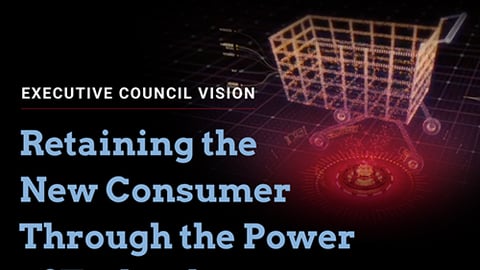Engaging in the Moment: Up Close with Treasure Data’s Danica Konetski
Having a firm grasp on today’s trends in consumer purchase habits and brand loyalty — not to mention the foresight to see what changes are ahead — are crucial for success for both modern retailers and consumer goods companies. It’s a skillset acutely honed by Danica Konetski, thanks to more than two decades of experience in consumer insights and strategy at Kraft Foods and ConAgra.
Now the industry principal for consumer verticals at Treasure Data, she marries this experience with her consulting background to partner with CPGs on their digital transformations and consumer-centric business strategies.
We reached out to the CGT/RIS Executive Council member to get her thoughts on how brands can prepare for the future of direct-to-consumer, what’s effecting real change in personalization, and the e-commerce metrics brands should prioritize (if they’re not already).
CGT: Treasure Data recently conducted a survey surrounding consumer purchase habits and brand loyalty, and one of the findings was that consumers expect to make more direct-to-consumer purchases from brands this year. What can you share about their motivation?
COVID was a compelling force for many consumers to change their buying habits, relying much more on digital channels. DTC may be a different business model for CPGs, but for the consumer it's a natural extension and a way to engage their favorite brands directly with more influence on the experience. Regardless of channel, consumers seek meaningful experiences, respectful interactions, quality solutions, convenience, and affordability.
EC Member Shares
How long have you been with Treasure Data?
About a year
What book is on your nightstand or to-do list?
“Thank you for Being Late”
Favorite junk food?
Ice cream
Subscription you can't live without?
Rent the Runway
Fill in the blank: "In 2022, I can't wait to ..."
Travel internationally again
Engaging with a brand in the moment can create exceptionally satisfying and personalized experiences, building strong brand affinity, relationship, and loyalty. And when consumers buy directly, companies with highly developed personalization capabilities can offer the easiest way to curate the exact type and quality of product desired, seamlessly, and often for a better price.
Many consumers feel that the online web experience that they get with brands is an overall better experience than that of large retailers. Online, consumers can find access to the full range of a brand’s portfolio, including exclusive products and services, and they can also benefit more easily from a brand’s loyalty programs.
With all of the information at their fingertips, shoppers can quickly identify the product that best meets their needs. This includes the ability to build your own multipack, even co-create the product with ingredient choices in some cases, and to have it delivered automatically on your own schedule.
CGT: How can brands and retailers better prepare for this trend moving forward?
Businesses offering DTC are effectively on the front line with consumers. So they really must rethink service and become service-led. As digital technology advances, brands will need to think creatively about how consumers will seek to engage, including gaming, voice, and contactless options. This includes navigating the shopping and buying processes, ensuring fast and convenient shipping and returns at no or low cost, in the manner and time consumers want to interact (face-to-face, chatbot, telephony, and in-person interactions).
It is essential for brands to actively and systematically listen to — and learn from — their consumers, which they have to do to holistically deliver against these expectations. If you don’t, your competition will. Perfecting a brand’s consumer vision with robust consumer data is essential to being able to compete effectively.
In part because of COVID, a more tech savvy shopper has emerged who will continue to spend more online. Leaders will deliver online marketplaces that meet consumers’ high expectations for innovative, omnichannel experiences and flawless execution and service.
Social commerce is also becoming an increasingly important channel. Brands will need to have a strong social media program to drive engagement and conversion.
CGT: Similarly, the study found that marketers have matured in their personalization capabilities. What’s moved the needle for brands and retailers?
Leading consumer-centric organizations have made strides in centralizing customer data and data science to fuel all customer-facing teams and systems. Those organizations have moved away from mass campaigns and advertising based on demographics and other general third-party data and have been building up their own data to get to know their customers and identifying trends as they unfold.
So, it all starts with consumer data to have a full picture into individual consumers, including behavioral, demographic, attitudinal, biologic, and psychographic data. This data must then be analyzed with advanced capabilities like machine learning to orchestrate consumer journeys, personalize communications, and call center interactions and to make predictive product recommendations. This personalization, enabled by data, not only improves the consumer experience but also helps marketers improve marketing performance.
CGT: What are the e-commerce metrics you think brands can derive the most value from and should be prioritizing, if they're not already?
My clients tend to focus on abandoned carts, conversion, cost-per-acquisition, retention, churn prevention, customer lifetime value (CLV), website visits, cross-purchase, loyalty, user-generated content, and profitability.
CGT: What are some of the emerging technologies that you think will affect the most change in the next 5-10 years?
Elevated consumer expectations and changing privacy regulations, policies and laws, like GDPR and CCPA, compound the need for new technology to enable the changes in how marketing and advertising can create insights and track users.
Consumers want digital innovation and personalization while knowing that their data is being handled respectfully. Brands require advanced technology to meet these consumer expectations and to deliver seamless experiences across the consumer journey, manage inventory, and deliver products.
So, generally, you can put the capabilities needed into three buckets.
1. Data Foundation: A solid data foundation is required to connect all data and identities, including first-party data, acquired and stored in a compliant manner with real-time data integration.
2. Predictive Analytics And Machine Learning: Ability to easily access insights derived from the data to accurately segment consumers, not just on demographics and behavior, but also on attitudes, and interests. In addition, you need to understand how all of these can shift in various contexts. These insights become the foundation for timely and effective communication and promotions and product recommendations. Additionally, these advanced capabilities will also be used to predict opportunities and diagnose problems across the entire consumer journey and the end-to-end supply chain.
3. Engagement And Business Management Capabilities: More automated, data-empowered personalization, engagement, service, and fulfillment.
Some of the most exciting possibilities include the ability to feed consumer data into demand-driven reorder software to better manage the supply chain and inventory. I also think there’s a lot of promise in virtual and augmented reality apps that let consumers “try on” apparel, jewelry, hair, and beauty products. And on the logistics front, we could see some positive changes with the use of robots and drones for quicker ordering, shipping, and delivery.








